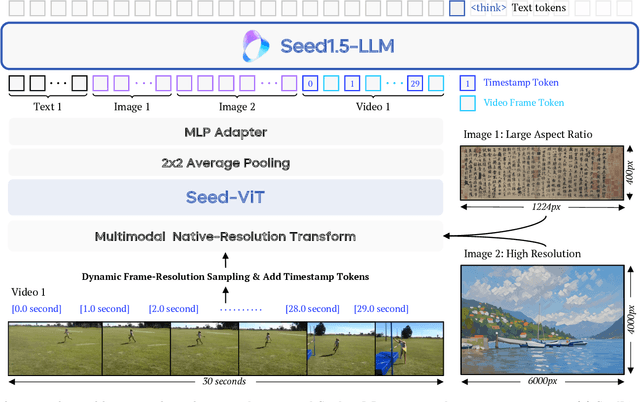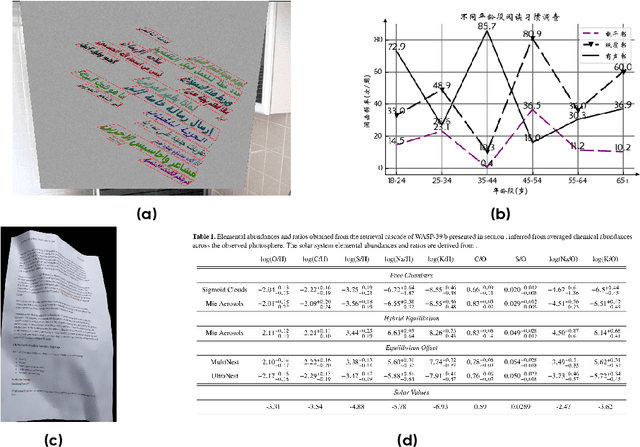Lei Li
Carnegie Mellon University
Wav2Sem: Plug-and-Play Audio Semantic Decoupling for 3D Speech-Driven Facial Animation
May 29, 2025Abstract:In 3D speech-driven facial animation generation, existing methods commonly employ pre-trained self-supervised audio models as encoders. However, due to the prevalence of phonetically similar syllables with distinct lip shapes in language, these near-homophone syllables tend to exhibit significant coupling in self-supervised audio feature spaces, leading to the averaging effect in subsequent lip motion generation. To address this issue, this paper proposes a plug-and-play semantic decorrelation module-Wav2Sem. This module extracts semantic features corresponding to the entire audio sequence, leveraging the added semantic information to decorrelate audio encodings within the feature space, thereby achieving more expressive audio features. Extensive experiments across multiple Speech-driven models indicate that the Wav2Sem module effectively decouples audio features, significantly alleviating the averaging effect of phonetically similar syllables in lip shape generation, thereby enhancing the precision and naturalness of facial animations. Our source code is available at https://github.com/wslh852/Wav2Sem.git.
R2MED: A Benchmark for Reasoning-Driven Medical Retrieval
May 20, 2025Abstract:Current medical retrieval benchmarks primarily emphasize lexical or shallow semantic similarity, overlooking the reasoning-intensive demands that are central to clinical decision-making. In practice, physicians often retrieve authoritative medical evidence to support diagnostic hypotheses. Such evidence typically aligns with an inferred diagnosis rather than the surface form of a patient's symptoms, leading to low lexical or semantic overlap between queries and relevant documents. To address this gap, we introduce R2MED, the first benchmark explicitly designed for reasoning-driven medical retrieval. It comprises 876 queries spanning three tasks: Q&A reference retrieval, clinical evidence retrieval, and clinical case retrieval. These tasks are drawn from five representative medical scenarios and twelve body systems, capturing the complexity and diversity of real-world medical information needs. We evaluate 15 widely-used retrieval systems on R2MED and find that even the best model achieves only 31.4 nDCG@10, demonstrating the benchmark's difficulty. Classical re-ranking and generation-augmented retrieval methods offer only modest improvements. Although large reasoning models improve performance via intermediate inference generation, the best results still peak at 41.4 nDCG@10. These findings underscore a substantial gap between current retrieval techniques and the reasoning demands of real clinical tasks. We release R2MED as a challenging benchmark to foster the development of next-generation medical retrieval systems with enhanced reasoning capabilities. Data and code are available at https://github.com/R2MED/R2MED
Multimodal Mixture of Low-Rank Experts for Sentiment Analysis and Emotion Recognition
May 20, 2025Abstract:Multi-task learning (MTL) enables the efficient transfer of extra knowledge acquired from other tasks. The high correlation between multimodal sentiment analysis (MSA) and multimodal emotion recognition (MER) supports their joint training. However, existing methods primarily employ hard parameter sharing, ignoring parameter conflicts caused by complex task correlations. In this paper, we present a novel MTL method for MSA and MER, termed Multimodal Mixture of Low-Rank Experts (MMoLRE). MMoLRE utilizes shared and task-specific experts to distinctly model common and unique task characteristics, thereby avoiding parameter conflicts. Additionally, inspired by low-rank structures in the Mixture of Experts (MoE) framework, we design low-rank expert networks to reduce parameter and computational overhead as the number of experts increases. Extensive experiments on the CMU-MOSI and CMU-MOSEI benchmarks demonstrate that MMoLRE achieves state-of-the-art performance on the MSA task and competitive results on the MER task.
Strategic Planning and Rationalizing on Trees Make LLMs Better Debaters
May 20, 2025Abstract:Winning competitive debates requires sophisticated reasoning and argument skills. There are unique challenges in the competitive debate: (1) The time constraints force debaters to make strategic choices about which points to pursue rather than covering all possible arguments; (2) The persuasiveness of the debate relies on the back-and-forth interaction between arguments, which a single final game status cannot evaluate. To address these challenges, we propose TreeDebater, a novel debate framework that excels in competitive debate. We introduce two tree structures: the Rehearsal Tree and Debate Flow Tree. The Rehearsal Tree anticipates the attack and defenses to evaluate the strength of the claim, while the Debate Flow Tree tracks the debate status to identify the active actions. TreeDebater allocates its time budget among candidate actions and uses the speech time controller and feedback from the simulated audience to revise its statement. The human evaluation on both the stage-level and the debate-level comparison shows that our TreeDebater outperforms the state-of-the-art multi-agent debate system. Further investigation shows that TreeDebater shows better strategies in limiting time to important debate actions, aligning with the strategies of human debate experts.
MiMo: Unlocking the Reasoning Potential of Language Model -- From Pretraining to Posttraining
May 12, 2025Abstract:We present MiMo-7B, a large language model born for reasoning tasks, with optimization across both pre-training and post-training stages. During pre-training, we enhance the data preprocessing pipeline and employ a three-stage data mixing strategy to strengthen the base model's reasoning potential. MiMo-7B-Base is pre-trained on 25 trillion tokens, with additional Multi-Token Prediction objective for enhanced performance and accelerated inference speed. During post-training, we curate a dataset of 130K verifiable mathematics and programming problems for reinforcement learning, integrating a test-difficulty-driven code-reward scheme to alleviate sparse-reward issues and employing strategic data resampling to stabilize training. Extensive evaluations show that MiMo-7B-Base possesses exceptional reasoning potential, outperforming even much larger 32B models. The final RL-tuned model, MiMo-7B-RL, achieves superior performance on mathematics, code and general reasoning tasks, surpassing the performance of OpenAI o1-mini. The model checkpoints are available at https://github.com/xiaomimimo/MiMo.
Seed1.5-VL Technical Report
May 11, 2025



Abstract:We present Seed1.5-VL, a vision-language foundation model designed to advance general-purpose multimodal understanding and reasoning. Seed1.5-VL is composed with a 532M-parameter vision encoder and a Mixture-of-Experts (MoE) LLM of 20B active parameters. Despite its relatively compact architecture, it delivers strong performance across a wide spectrum of public VLM benchmarks and internal evaluation suites, achieving the state-of-the-art performance on 38 out of 60 public benchmarks. Moreover, in agent-centric tasks such as GUI control and gameplay, Seed1.5-VL outperforms leading multimodal systems, including OpenAI CUA and Claude 3.7. Beyond visual and video understanding, it also demonstrates strong reasoning abilities, making it particularly effective for multimodal reasoning challenges such as visual puzzles. We believe these capabilities will empower broader applications across diverse tasks. In this report, we mainly provide a comprehensive review of our experiences in building Seed1.5-VL across model design, data construction, and training at various stages, hoping that this report can inspire further research. Seed1.5-VL is now accessible at https://www.volcengine.com/ (Volcano Engine Model ID: doubao-1-5-thinking-vision-pro-250428)
TimeChat-Online: 80% Visual Tokens are Naturally Redundant in Streaming Videos
Apr 24, 2025Abstract:The rapid growth of online video platforms, particularly live streaming services, has created an urgent need for real-time video understanding systems. These systems must process continuous video streams and respond to user queries instantaneously, presenting unique challenges for current Video Large Language Models (VideoLLMs). While existing VideoLLMs excel at processing complete videos, they face significant limitations in streaming scenarios due to their inability to handle dense, redundant frames efficiently. We introduce TimeChat-Online, a novel online VideoLLM that revolutionizes real-time video interaction. At its core lies our innovative Differential Token Drop (DTD) module, which addresses the fundamental challenge of visual redundancy in streaming videos. Drawing inspiration from human visual perception's Change Blindness phenomenon, DTD preserves meaningful temporal changes while filtering out static, redundant content between frames. Remarkably, our experiments demonstrate that DTD achieves an 82.8% reduction in video tokens while maintaining 98% performance on StreamingBench, revealing that over 80% of visual content in streaming videos is naturally redundant without requiring language guidance. To enable seamless real-time interaction, we present TimeChat-Online-139K, a comprehensive streaming video dataset featuring diverse interaction patterns including backward-tracing, current-perception, and future-responding scenarios. TimeChat-Online's unique Proactive Response capability, naturally achieved through continuous monitoring of video scene transitions via DTD, sets it apart from conventional approaches. Our extensive evaluation demonstrates TimeChat-Online's superior performance on streaming benchmarks (StreamingBench and OvOBench) and maintaining competitive results on long-form video tasks such as Video-MME and MLVU.
Mind2Matter: Creating 3D Models from EEG Signals
Apr 16, 2025Abstract:The reconstruction of 3D objects from brain signals has gained significant attention in brain-computer interface (BCI) research. Current research predominantly utilizes functional magnetic resonance imaging (fMRI) for 3D reconstruction tasks due to its excellent spatial resolution. Nevertheless, the clinical utility of fMRI is limited by its prohibitive costs and inability to support real-time operations. In comparison, electroencephalography (EEG) presents distinct advantages as an affordable, non-invasive, and mobile solution for real-time brain-computer interaction systems. While recent advances in deep learning have enabled remarkable progress in image generation from neural data, decoding EEG signals into structured 3D representations remains largely unexplored. In this paper, we propose a novel framework that translates EEG recordings into 3D object reconstructions by leveraging neural decoding techniques and generative models. Our approach involves training an EEG encoder to extract spatiotemporal visual features, fine-tuning a large language model to interpret these features into descriptive multimodal outputs, and leveraging generative 3D Gaussians with layout-guided control to synthesize the final 3D structures. Experiments demonstrate that our model captures salient geometric and semantic features, paving the way for applications in brain-computer interfaces (BCIs), virtual reality, and neuroprosthetics.Our code is available in https://github.com/sddwwww/Mind2Matter.
Could Thinking Multilingually Empower LLM Reasoning?
Apr 16, 2025Abstract:Previous work indicates that large language models exhibit a significant "English bias", i.e. they often perform better when tasks are presented in English. Interestingly, we have observed that using certain other languages in reasoning tasks can yield better performance than English. However, this phenomenon remains under-explored. In this paper, we explore the upper bound of harnessing multilingualism in reasoning tasks, suggesting that multilingual reasoning promises significantly (by nearly 10 Acc@$k$ points) and robustly (tolerance for variations in translation quality and language choice) higher upper bounds than English-only reasoning. Besides analyzing the reason behind the upper bound and challenges in reaching it, we also find that common answer selection methods cannot achieve this upper bound, due to their limitations and biases. These insights could pave the way for future research aimed at fully harnessing the potential of multilingual reasoning in LLMs.
Quantum-Enhanced LLM Efficient Fine Tuning
Mar 17, 2025Abstract:Low-Rank Adaptation (LoRA) enables efficient fine-tuning of pre-trained language models via low-rank matrix approximation, which is effective in many scenarios. However, its low-rank representation capacity is constrained in complex tasks or high-rank dependency settings, potentially limiting model adaptability. Addressing the expressive bottleneck of classical low-rank approximation in fine-tuning large language models, this paper proposes a parameter-efficient fine-tuning method based on a Quantum Weighted Tensor Hybrid Network (QWTHN), which leverages Quantum Neural Network (QNN). The study investigates quantum-classical hybrid parameter-efficient fine-tuning in low-rank spaces. QWTHN decomposes pre-trained weights into quantum neural network and tensor network representations, utilizing quantum state superposition and other methods to break through classical rank limitations. Experiments show that the proposed quantum fine-tuning technique for large models approaches or even surpasses the parameter efficiency of LoRA. On the CPsyCounD and R1-Distill-SFT datasets, QWTHN, compared to classical LoRA, reduces training loss by up to 15% while using 76% fewer parameters, and achieves an 8.4% performance improvement on the CPsyCounD test set. This research not only realizes lightweight and efficient adaptation of quantum resources to billion-parameter models but also validates the practical path of quantum hardware driven by large model tasks, laying the first engineering-ready technical foundation for future quantum-enhanced AGI systems.
 Add to Chrome
Add to Chrome Add to Firefox
Add to Firefox Add to Edge
Add to Edge